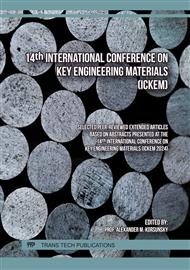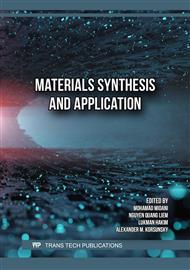[1]
R.B. Cloward, The treatment of ruptured lumbar intervertebral discs by vertebral body fusion: I. Indications, operative technique, after care, Journal of neurosurgery. 10(2) (1953) 154-168.
DOI: 10.3171/jns.1953.10.2.0154
Google Scholar
[2]
R.B. Cloward, 4 Lesions of the Intervertebral Disks and Their Treatment by Interbody Fusion Methods The Painful Disk, Clinical Orthopaedics and Related Research (1976-2007). 27 (1963) 51-77.
DOI: 10.1097/00003086-196300270-00006
Google Scholar
[3]
B. Meng, J. Bunch, D. Burton, J. Wang, Lumbar interbody fusion: recent advances in surgical techniques and bone healing strategies, European Spine Journal. 30 (2021) 22-33.
DOI: 10.1007/s00586-020-06596-0
Google Scholar
[4]
W.F. Lestini, J.S. Fulghum, L.A. Whitehurst, Lumbar spinal fusion: advantages of posterior lumbar interbody fusion, Surgical technology international. 3 (1994) 577-590.
Google Scholar
[5]
C.D. Cole, T.D. McCall, M.H. Schmidt, A.T. Dailey, Comparison of low back fusion techniques: transforaminal lumbar interbody fusion (TLIF) or posterior lumbar interbody fusion (PLIF) approaches, Current reviews in musculoskeletal medicine. 2 (2009) 118-126.
DOI: 10.1007/s12178-009-9053-8
Google Scholar
[6]
G.R. Fogel, J.S. Toohey, A. Neidre, J.W. Brantigan, Is one cage enough in posterior lumbar interbody fusion: a comparison of unilateral single cage interbody fusion to bilateral cages, Clinical Spine Surgery. 20(1) (2007) 60-65.
DOI: 10.1097/01.bsd.0000211251.59953.a4
Google Scholar
[7]
Verma, R., Kumar, J., Singh, N. K., Rai, S. K., Saxena, K. K., & Xu, J. (2022). Design and analysis of biomedical scaffolds using TPMS-based porous structures inspired from additive manufacturing. Coatings, 12(6), 839.
DOI: 10.3390/coatings12060839
Google Scholar
[8]
H.R. Newman, J.F. DeLucca, J.M. Peloquin, E.J. Vresilovic, D.M. Elliott, Multiaxial validation of a finite element model of the intervertebral disc with multigenerational fibers to establish residual strain. JOR spine. 4(2), (2021) e1145.
DOI: 10.1002/jsp2.1145
Google Scholar
[9]
R. Remus, A. Lipphaus, M. Neumann, B. Bender, Calibration and validation of a novel hybrid model of the lumbosacral spine in ArtiSynth–The passive structures, PLoS One. 16(4) (2021) e0250456.
DOI: 10.1371/journal.pone.0250456
Google Scholar
[10]
A.A. WHITE III, Clinical biomechanics of cervical spine implants, Spine. 14(10) (1989) 1040-1045.
DOI: 10.1097/00007632-198910000-00002
Google Scholar
[11]
V.K. Goel, B.T. Monroe, L.G. Gilbertson, P. Brinckmann, Interlaminar shear stresses and laminae separation in a disc: finite element analysis of the L3-L4 motion segment subjected to axial compressive loads. Spine. 20(6) (1995) 689-698.
DOI: 10.1097/00007632-199503150-00010
Google Scholar
[12]
Z. Xiao, L. Wang, H. Gong, J. Gao, X. Zhang, Establishment and verification of a non-linear finite element model for human L4–L5 lumbar segment. In 2010 3rd International Conference on Biomedical Engineering and Informatics, IEEE. 3 (2010) 1171-1175.
DOI: 10.1109/bmei.2010.5639592
Google Scholar
[13]
P.R. Landham, A.S. Don, P.A. Robertson, Do position and size matter? An analysis of cage and placement variables for optimum lordosis in PLIF reconstruction, European Spine Journal. 26 (2017) 2843-2850.
DOI: 10.1007/s00586-017-5170-z
Google Scholar
[14]
T.V. Le, A.A. Baaj, E. Dakwar, C.J. Burkett, G. Murray, D.A. Smith, J.S. Uribe, Subsidence of polyetheretherketone intervertebral cages in minimally invasive lateral retroperitoneal transpsoas lumbar interbody fusion, Spine. 37(14) (2012) 1268-1273.
DOI: 10.1097/brs.0b013e3182458b2f
Google Scholar
[15]
Y.H. Lee, C.J. Chung, C.W. Wang, Y.T. Peng, C.H. Chang, C.H. Chen, Y.N. Chen, C.T. Li, Computational comparison of three posterior lumbar interbody fusion techniques by using porous titanium interbody cages with 50% porosity, Computers in biology and medicine. 71 (2016) 35-45.
DOI: 10.1016/j.compbiomed.2016.01.024
Google Scholar
[16]
Q.Y. Li, H.J. Kim, J. Son, K.T. Kang, B.S. Chang, C.K. Lee, H.S. Seok, J.S. Yeom, Biomechanical analysis of lumbar decompression surgery in relation to degenerative changes in the lumbar spine–Validated finite element analysis, Computers in biology and medicine. 89 (2017) 512-519.
DOI: 10.1016/j.compbiomed.2017.09.003
Google Scholar
[17]
P.M. Lin, Posterior lumbar interbody fusion (PLIF): past, present, and future, Clinical Neurosurgery. 47 (2000) 470-482.
Google Scholar
[18]
Y.M. Lu, W.C. Hutton, V.M. Gharpuray, Do bending, twisting, and diurnal fluid changes in the disc affect the propensity to prolapse? A viscoelastic finite element model, Spine. 21(22) (1996) 2570-2579.
DOI: 10.1097/00007632-199611150-00006
Google Scholar
[19]
R.J. Bianco, P.J. Arnoux, E. Wagnac, J.M. Mac-Thiong, C.E. Aubin, minimizing pedicle screw pullout risks: a detailed biomechanical analysis of screw design and placement, Clin Spine Surg. 30(3) (2017) E226–E232.
DOI: 10.1097/bsd.0000000000000151
Google Scholar
[20]
Z. Zhang, G.R. Fogel, Z. Liao, Y. Sun, W. Liu, Biomechanical analysis of lateral lumbar interbody fusion constructs with various fixation options: based on a validated finite element model, World neurosurgery. 114 (2018) e1120-e1129.
DOI: 10.1016/j.wneu.2018.03.158
Google Scholar
[21]
Y.F. Zhang, H.L. Yang, J.W. Wang, T.S. Tang, Two‐year follow‐up results after treatment of lumbar instability with titanium‐coated fusion system, Orthopaedic surgery. 1(2) (2009) 94-100.
DOI: 10.1111/j.1757-7861.2009.00026.x
Google Scholar
[22]
C.C. Lo, K.J. Tsai, Z.C. Zhong, S.H. Chen, C. Hung, Biomechanical differences of Coflex-F and pedicle screw fixation combined with TLIF or ALIF–a finite element study, Computer methods in biomechanics and biomedical engineering. 14(11) (2011) 947-956.
DOI: 10.1080/10255842.2010.501762
Google Scholar
[23]
D.V. Ambati, E.K. Wright Jr, R.A. Lehman Jr, D.G. Kang, S.C. Wagner, A.E. Dmitriev, Bilateral pedicle screw fixation provides superior biomechanical stability in transforaminal lumbar interbody fusion: a finite element study, The spine journal. 15(8) (2015) 1812-1822.
DOI: 10.1016/j.spinee.2014.06.015
Google Scholar
[24]
M. Dreischarf, T. Zander, A. Shirazi-Adl, C.M. Puttlitz, C.J. Adam, C.S. Chen, V.K. Goel, A. Kiapour, Y.H. Kim, K.M. Labus, J.P. Little, W.M. Park, Y.H. Wang, H.J. Wilke, A. Rohlmann, H. Schmidt, Comparison of eight published static finite element models of the intact lumbar spine: predictive power of models improves when combined together, Journal of biomechanics. 47(8) (2014) 1757-1766.
DOI: 10.1016/j.jbiomech.2014.04.002
Google Scholar
[25]
M.F. Chiang, Z.C. Zhong, C.S. Chen, C.K. Cheng, S.L. Shih, Biomechanical comparison of instrumented posterior lumbar interbody fusion with one or two cages by finite element analysis, Spine. 31(19) (2006) E682-E689.
DOI: 10.1097/01.brs.0000232714.72699.8e
Google Scholar
[26]
J.J. Carmouche, R.W. Molinari, Epidural abscess and discitis complicating instrumented posterior lumbar interbody fusion: a case report, Spine. 29(23) (2004) E542-E546.
DOI: 10.1097/01.brs.0000146802.38753.38
Google Scholar
[27]
E.M. Pinto, A. Teixeira, R. Frada, P. Atilano, A. Miranda, Surgical risk factors associated with the development of adjacent segment pathology in the lumbar spine, EFORT open reviews. 6(10) (2021) 966-972.
DOI: 10.1302/2058-5241.6.210050
Google Scholar
[28]
Y. Hou, H. Shi, H. Shi, T. Zhao, J. Shi, G. Shi, A meta-analysis of risk factors for cage migration after lumbar fusion surgery, World Neurosurgery: X. (2023). 100152.
DOI: 10.1016/j.wnsx.2023.100152
Google Scholar
[29]
A. Nassr, J.Y. Lee, R.S. Bashir, J.A. Rihn, J.C. Eck, J.D. Kang, M.R. Lim, Does incorrect level needle localization during anterior cervical discectomy and fusion lead to accelerated disc degeneration?, Spine. 34(2) (2009) 189-192.
DOI: 10.1097/brs.0b013e3181913872
Google Scholar
[30]
M. D'Souza, N.A. Macdonald, J.L. Gendreau, P.J. Duddleston, A.Y. Feng, A.L. Ho, Graft materials and biologics for spinal interbody fusion, Biomedicines. 7(4) (2019) 75.
DOI: 10.3390/biomedicines7040075
Google Scholar
[31]
C.M. Shih, C.H. Lee, K.H. Chen, C.C. Pan, Y.C. Yen, C.H. Wang, K.C. Su, Optimizing Spinal Fusion Cage Design to Improve Bone Substitute Filling on Varying Disc Heights: A 3D Printing Study, Bioengineering. 10(11) (2023) 1250.
DOI: 10.3390/bioengineering10111250
Google Scholar
[32]
M.J. Voor, S. Mehta, M. Wang, Y.M. Zhang, J. Mahan, J.R. Johnson, Biomechanical evaluation of posterior and anterior lumbar interbody fusion techniques, Clinical Spine Surgery. 11(4) (1998) 328-334.
DOI: 10.1097/00002517-199808000-00011
Google Scholar
[33]
H.J. Wilke, P. Neef, M. Caimi, T. Hoogland, L.E. Claes, New in vivo measurements of pressures in the intervertebral disc in daily life, Spine. 24(8) (1999) 755-762.
DOI: 10.1097/00007632-199904150-00005
Google Scholar
[34]
B.W. Cunningham, N. Hu, C.M. Zorn, P.C. McAfee, Biomechanical evaluation of threaded cages for lumbar interbody fusion, Spine. 27(4) (2002) 363-367.
Google Scholar
[35]
H.J. Wilke, K. Wenger, L. Claes, Testing criteria for spinal implants: recommendations for the standardization of in vitro stability testing of spinal implants, European spine journal. 7 (1998) 148-154.
DOI: 10.1007/s005860050045
Google Scholar
[36]
G. Ghiselli, N. Wharton, J.A. Hipp, D.A. Wong, S. Jatana, Prospective Analysis of Imaging Prediction of Pseudarthrosis After Anterior Cervical Discectomy and Fusion: Computed Tomography: Versus: Flexion-Extension Motion Analysis With Intraoperative Correlation, Spine, 36(6) (2011) 463-468.
DOI: 10.1097/brs.0b013e3181d7a81a
Google Scholar
[37]
A. Kettler, H.J. Wilke, R. Dietl, M. Krammer, C. Lumenta, L. Claes, Stabilizing effect of posterior lumbar interbody fusion cages before and after cyclic loading, Journal of Neurosurgery: Spine. 92(1) (2000) 87-92.
DOI: 10.3171/spi.2000.92.1.0087
Google Scholar
[38]
A.A. WHITE III, M.M. PANJABI, The role of stabilization in the treatment of cervical spine injuries, Spine. 9(5) (1984) 512-522.
DOI: 10.1097/00007632-198407000-00021
Google Scholar
[39]
C.S. Kuo, H.T. Hu, L.C. Wu, C.L. Sun, Biomechanical analysis of different types of lumbar reconstruction devices, Clinical Biomechanics. 24(6) (2009) 467-472.
Google Scholar
[40]
J. Wu, Q. Feng, D. Yang, H. Xu, W. Wen, H. Xu, J. Miao, Biomechanical evaluation of different sizes of 3D printed cage in lumbar interbody fusion-a finite element analysis, BMC Musculoskeletal Disorders. 24(1) (2023) 1-11.
DOI: 10.1186/s12891-023-06201-7
Google Scholar
[41]
R.M. Pilliar, H.U. Cameron, R.P. Welsh, A.G. Binnington, Radiographic and morphologic studies of load-bearing porous-surfaced structured implants, Clinical Orthopaedics and Related Research (1976-2007). (1981) 156, 249-257.
DOI: 10.1097/00003086-198105000-00037
Google Scholar
[42]
M. Lin, S.Z. Shapiro, J. Doulgeris, E.D. Engeberg, C.T. Tsai, F.D. Vrionis, Cage-screw and anterior plating combination reduces the risk of micromotion and subsidence in multilevel anterior cervical discectomy and fusion—A finite element study, The Spine Journal. 21(5) (2021) 874-882.
DOI: 10.1016/j.spinee.2021.01.015
Google Scholar
[43]
E.H. Ledet, G.P. Sanders, D.J. DiRisio, J.C. Glennon, Load-sharing through elastic micro-motion accelerates bone formation and interbody fusion, The Spine Journal. 18(7) (2018) 1222-1230.
DOI: 10.1016/j.spinee.2018.02.004
Google Scholar
[44]
D.W. Overaker, N.A. Langrana, A.M. Cuitin˜ o, (1999). Finite element analysis of vertebral body mechanics with a nonlinear microstructural model for the trabecular core.
DOI: 10.1115/1.2835085
Google Scholar
[45]
A. Polikeit, S.J. Ferguson, L.P. Nolte, T.E. Orr, Factors influencing stresses in the lumbar spine after the insertion of intervertebral cages: finite element analysis, European spine journal. 12 (2003) 413-420.
DOI: 10.1007/s00586-002-0505-8
Google Scholar



